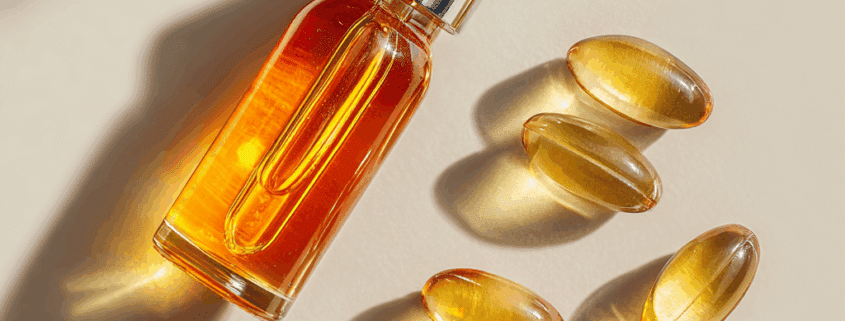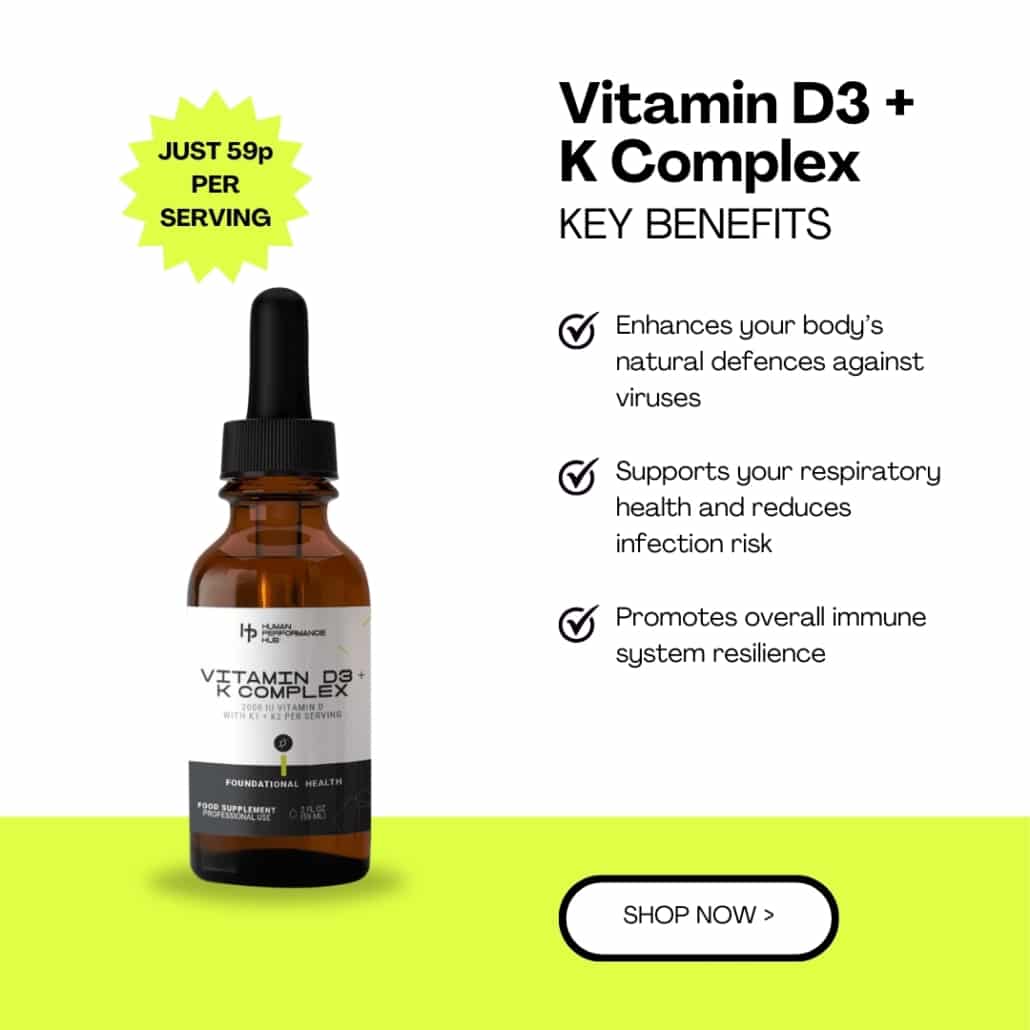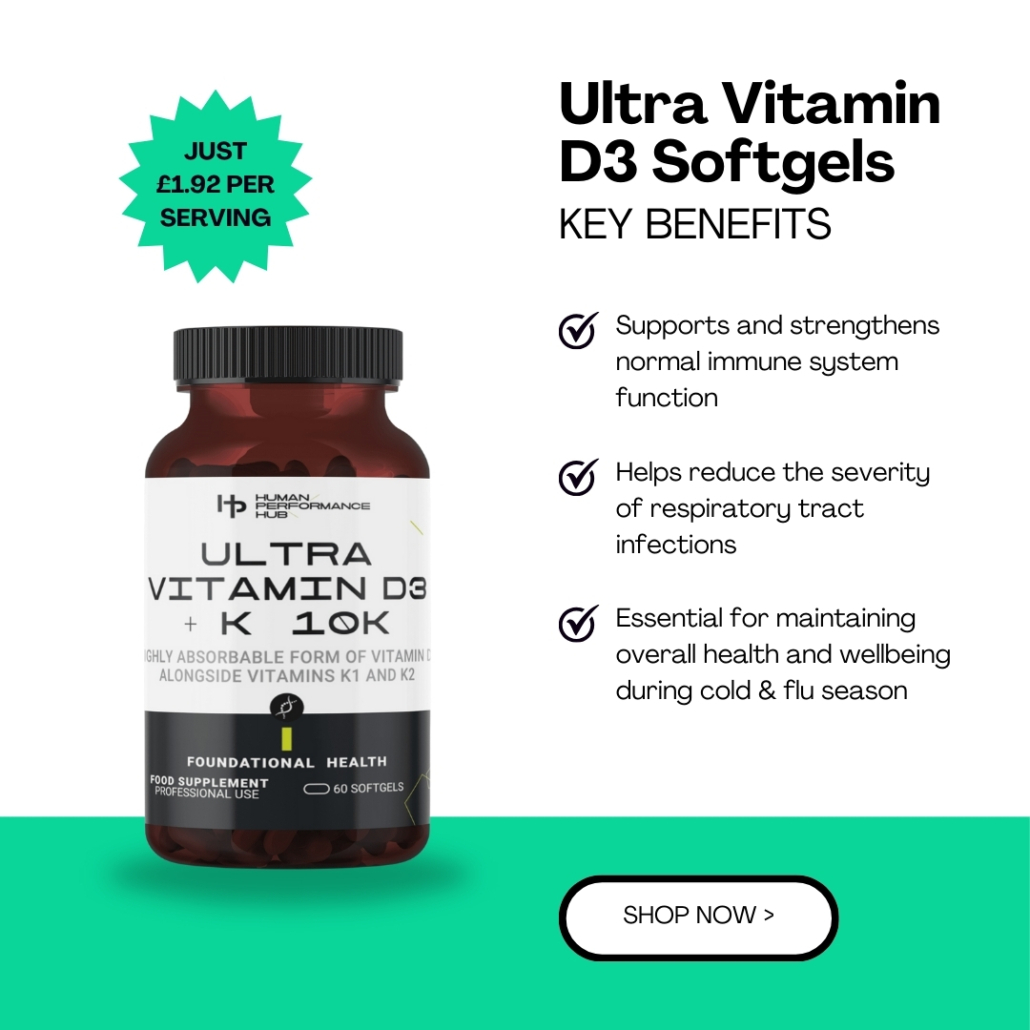By Roan Heming | Updated: 25th August 2025 | Reading time: 7~8 minutes
Most people are told to take calcium (and often vitamin D) for bones. Yet I keep meeting clients with decent calcium intake who still show bone loss on scans—while a clinician flags arterial calcification risk. That head-scratch moment has a name: the calcium paradox. The fix isn’t “more calcium”; it’s better calcium traffic control—and that’s where vitamin K2 earns its keep.
The short version
- Vitamin D3 helps you absorb calcium.
- Vitamin K2 helps you use calcium in the right places—into bones and teeth, away from arteries and soft tissues.
- Without enough K2, two key proteins—osteocalcin (bones/teeth) and matrix Gla protein, MGP (blood vessels)—stay inactive, so calcium is more likely to end up where you don’t want it. (PMC, PubMed)
A quick word about the book & author
This idea was popularised for the general public by Vitamin K2 and the Calcium Paradox by Kate Rhéaume-Bleue, ND, a Canadian author and naturopathic doctor. She trained at the Canadian College of Naturopathic Medicine and has written extensively for lay readers on nutrition and bone/heart health. (Google Books, HarperCollins)
What the science actually says (kept simple)
1) Mechanism you can picture
- Osteocalcin and MGP are vitamin-K-dependent proteins. K2 “switches them on” (carboxylation). Active osteocalcin helps lock minerals into bone/teeth; active MGP helps block calcification in arteries. (PMC, PubMed)
2) Population & clinical signals
- In the Rotterdam Study, people eating more K2 (menaquinones) had less aortic calcification, lower CHD risk, and lower CVD mortality—K1 didn’t show the same signal. Observational, but important. (PubMed)
- The blood marker dp-ucMGP (the inactive form of MGP) is consistently linked with more vascular calcification and higher CVD risk—useful for research context, not a routine NHS test. (PMC, atherosclerosis-journal.com)
3) Randomised trials (bones)
- MK-7 (K2) for 3 years in post-menopausal women slowed the age-related decline in BMD and improved K-status in one well-known RCT. (PubMed)
- But evidence isn’t one-way: another 3-year MK-7 trial (both groups also received vitamin D3 and calcium) did not show a BMD advantage vs placebo. Science evolves; context matters. (PubMed)
- In Japan, high-dose MK-4 (menatetrenone, 45 mg/day)—a prescription-style dose—has reduced fractures in osteoporotic women across several trials (a different use-case than typical nutrition doses). (PMC, PubMed)
Bottom line from me: biology is solid; bone evidence is promising (not perfect), and the vascular story is encouraging but still building. Pairing D3 + K2 is a sensible, low-friction way to help calcium go to the right places.
Vitamin D3 and K2 matter all year (yes, even in summer)
In the UK, the NHS advises everyone to consider 10 µg (400 IU) vitamin D daily in autumn/winter. In spring/summer, many people make enough from sunlight—but not everyone (indoor workers, those who cover skin, or with darker skin may still need a supplement all year). (nhs.uk)
Meanwhile, keeping K2 steady—via food and/or a supplement—helps ensure calcium is directed properly whenever you’re absorbing more (from diet, supplements, or brighter months). Note: the commonly used MK-7 form hangs around longer in the blood (half-life in the ~2–3 days range), which is why once-daily dosing works well. (PubMed, PMC)
Food first (then supplement)
- Best K2 foods: natto (the king), aged cheeses like Jarlsberg/Gouda/Edam, and some pasture-raised egg yolks/dairy (MK-4). A small RCT with Jarlsberg showed favourable changes in osteocalcin (a K-dependent bone marker). (PubMed)
- If natto isn’t your vibe (fair!), a quality K2 (MK-7) supplement is an easy back-up.
How I stack this at HPH (safe & straightforward)
Daily, steady approach (most people)
- HPH Vitamin D3 + K Complex – pairs D3 (absorb) with K2 (direct) in one easy habit.
→ Shop HPH Vitamin D3 + K Complex
Higher-dose vitamin D users (time-limited, supervised)
- HPH Ultra Vitamin D3 + K 10K – designed for guided 10,000 IU D3 phases to correct low status; built-in K supports sensible calcium handling while you replete.
→ Shop HPH Ultra Vitamin D3 + K 10K
Coach’s safety note: If you’re on warfarin or another vitamin-K-antagonist anticoagulant, speak to your prescriber before using vitamin K. Keep D3 within evidence-based ranges unless a clinician advises otherwise (and re-test to personalise). (nhs.uk)
How to check your bone density in the UK (normal people’s guide)
1) Start with a fracture-risk check
Use the free FRAX calculator (choose UK) to estimate your 10-year fracture probability. If you already have a femoral-neck BMD from a scan, add it; if not, you can still run FRAX on clinical risk factors. (frax.shef.ac.uk)
2) Book a bone density scan if indicated
The standard test is a DEXA (also written DXA) scan—quick, painless, very low radiation. Your GP can refer you when risk is elevated; private options exist too. Results come as a T-score (normal, osteopenia, or osteoporosis) and are interpreted alongside age, fracture history, meds, etc. (not in isolation). (nhs.uk, theros.org.uk)
3) Know the basic UK guidance
- Who gets scanned? Typically those >50 with risk factors or <50 with notable risks (e.g., fragility fracture, certain medications). (nhs.uk)
- What do pros use? Clinicians follow NOGG guidance for assessment/treatment and use FRAX ± DEXA to decide on next steps. (nogg.org.uk)
Results to expect (and how we measure them)
- Bones: Over months to years, we aim to stabilise or improve BMD and see healthy bone-turnover markers.
- Vessels: We don’t claim magic, but K-dependent MGP activation is one way we help the body resist inappropriate calcification while you manage the big rocks (training, nutrition, sleep, bloods). (PubMed)
FAQs (I get these daily)
Is K1 from greens enough?
Great for normal clotting, but K2 is the form most associated with bone and vascular tissues. I coach clients to get both. (PMC)
Do I still need K2 if I don’t take calcium?
Yes—K2 is about directing the calcium you absorb from food and D3, not just tablets. It’s a “traffic warden,” not a calcium booster. (PMC)
How long do you think I should notice anything?
This isn’t a stimulant. Think 8–12 weeks for vitamin D status checks and months to years for bone metrics (depending on your baseline and plan). (nhs.uk)
Coach’s take-home
If you’re serious about bone strength, dental health, and a calmer vascular story over decades, don’t run a calcium + D plan without the K2 traffic warden. Prioritise K2-rich foods, pair your D3 intelligently with K2, and personalise with simple testing and review.
When you’re ready, I’ve built the two simplest tools for you:
- ✅ Daily maintenance: HPH Vitamin D3 + K Complex
- ✅ Guided high-dose D users: HPH Ultra Vitamin D3 + K 10K
If you want my eyes on your current stack or bone/vascular labs, drop me an email at info@humanhubltd.co.uk, and we’ll map it out.
References
- Mechanism—bones & vessels:
Gundberg CM. Adv Nutr. Osteocalcin needs vitamin K-dependent carboxylation to function in bone. (PMC)
Schurgers LJ. Thromb Haemost. MGP is a vitamin-K-dependent inhibitor of vascular calcification. (PubMed) - Observational—heart & arteries:
Geleijnse JM et al. The Rotterdam Study: higher dietary K2 intake linked with less CHD and less aortic calcification. J Nutr. 2004. (PubMed)
Roumeliotis S et al. Review: inactive MGP (dp-ucMGP) associates with vascular calcification and mortality. Int J Mol Sci. 2019. (PMC)
Willeit K et al. dp-ucMGP linked to incident CVD and all-cause mortality. Atherosclerosis. 2022. (atherosclerosis-journal.com) - Randomised trials—bone outcomes:
Knapen MHJ et al. 3-year MK-7 improved K-status and slowed BMD decline in post-menopausal women. Osteoporosis Int. 2013. (PubMed)
Rønn SH et al. 3-year MK-7 (with D3 + calcium given to both groups) showed no BMD difference vs placebo. Osteoporosis Int. 2021. (PubMed)
Iwamoto J (review). High-dose MK-4 (45 mg/day) reduces fractures in Japanese trials (pharmacological context). Nutrients. 2014. (PMC) - Food sources & markers:
Lundberg HE et al. Jarlsberg cheese intake increased osteocalcin vs control cheese—supports K2-rich foods. BMJ Nutr Prev Health. 2022. (PubMed) - UK-specific vitamin D guidance (year-round context):
NHS: everyone should consider 10 µg (400 IU) D in autumn/winter; some groups should take it all year. (nhs.uk) - MK-7 half-life (why once-daily works):
Schurgers LJ et al. MK-7 has a longer half-life and keeps vitamin-K-dependent proteins active more consistently. Blood. 2007. (PubMed)
Mladěnka P et al. Review of K kinetics: MK-7 ~3-day half-life vs hours for K1. Nutrients. 2021. (PMC) - Bone density—how to test (UK):
NHS explainer on DEXA (what it is, who gets it, what results mean). (nhs.uk)
Royal Osteoporosis Society guide to DXA and interpreting T-scores in context. (theros.org.uk)
NOGG summary: UK guideline framework clinicians use for bone assessment/treatment. (nogg.org.uk)
FRAX (University of Sheffield): free tool for 10-year fracture risk (UK model available). (frax.shef.ac.uk)
General information only; not medical advice. If you take anticoagulant medication (e.g., warfarin) or have relevant medical conditions, consult your clinician before using vitamin K. Keep vitamin D within safe ranges unless otherwise advised, and re-test to personalise.






